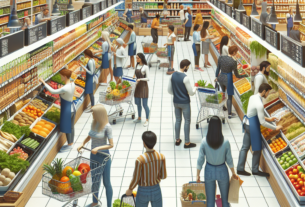The Role of Drones and Robots in Foodservice Supply Chains
Introduction
In recent years, the foodservice industry has seen a significant shift towards automation and technology-driven solutions to streamline operations and improve efficiency. One of the key areas where this transformation is taking place is in the use of drones and robots in foodservice supply chains. This report will explore the current state of the industry, trends, challenges, and innovations related to the integration of drones and robots in foodservice supply chains.
Current State of the Foodservice Industry
According to a report by CulinaryCoverage.com, the foodservice industry is projected to reach a market value of $4 trillion by 2025. This growth is driven by changing consumer preferences, increasing demand for convenience, and the rise of online food delivery services. As a result, foodservice operators are under pressure to improve their supply chain efficiency to meet the growing demand.
Market Share and Volumes
Leading players in the foodservice industry such as McDonald’s, Starbucks, and Domino’s Pizza have already started experimenting with drones and robots to enhance their supply chain operations. For example, Domino’s Pizza has successfully tested drone delivery in select markets, while Starbucks has implemented robotic arms in some of its stores to automate the coffee-making process.
Financials
The integration of drones and robots in foodservice supply chains is not only about improving operational efficiency but also about reducing costs. By automating certain tasks such as inventory management, order fulfillment, and delivery, foodservice operators can save on labor costs and minimize errors in the supply chain.
Trends in the Use of Drones and Robots
One of the key trends in the use of drones and robots in foodservice supply chains is the focus on last-mile delivery. Companies are exploring the use of drones and autonomous vehicles to deliver food directly to customers’ doorsteps, thereby reducing delivery times and costs. This trend is driven by the increasing demand for on-demand food delivery services and the need for faster and more efficient delivery options.
Future Plans
Looking ahead, the use of drones and robots in foodservice supply chains is expected to become more widespread. Companies are investing in research and development to improve the capabilities of drones and robots, making them more efficient and cost-effective for use in the foodservice industry. In the coming years, we can expect to see more automation in foodservice operations, from food preparation to delivery.
Challenges and Innovations
While the integration of drones and robots in foodservice supply chains offers many benefits, there are also challenges that need to be addressed. One of the main challenges is the regulatory environment, as many countries have strict regulations regarding the use of drones for commercial purposes. Companies need to navigate these regulations and obtain the necessary permits to operate drones and robots in foodservice supply chains.
Examples and Scenarios
One example of innovation in the use of drones and robots in foodservice supply chains is the development of autonomous robotic kitchens. These kitchens are equipped with robotic arms and AI-powered systems that can prepare and cook food with minimal human intervention. This innovation not only improves efficiency but also ensures consistency in food quality and safety.
Conclusion
In conclusion, the integration of drones and robots in foodservice supply chains is a growing trend that offers many benefits to foodservice operators. By leveraging automation and technology-driven solutions, companies can improve their supply chain efficiency, reduce costs, and meet the increasing demand for on-demand food delivery services. As technology continues to advance, we can expect to see more innovations in the use of drones and robots in the foodservice industry, transforming the way food is prepared, delivered, and consumed.


